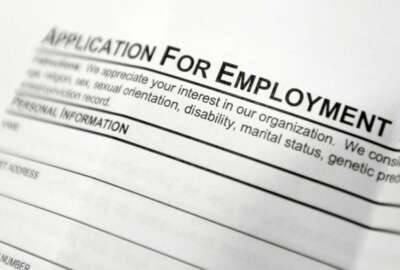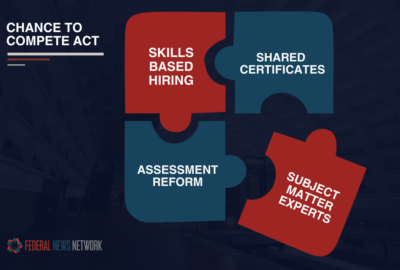Telework changes, hiring reforms of 2023 charting a course into the new year
Telework and return-to-office changes at agencies were far from the only pivot for the federal workforce in 2023.
For the federal workforce, 2023 was yet another pivotal year — defined by changes not only to the federal workplace, but also to the government’s recruitment and retention strategies.
What this year perhaps most notably marked was a pivot in agencies’ telework policies and return-to-office plans. After the Office of Management and Budget’s call to ramp up “meaningful” in-office work, agencies led a slow, one-by-one release of their individual plans to heed the White House memo.
Depending on their agency, many federal employees’ partial return to the office began in the late summer of 2023 and lasted through the fall — some changes will take place even further ahead, beginning in early 2024.
The Biden administration’s goal was to strike a balance between telework and in-office presence for feds, but the changes from agencies did not happen without pushback. Many federal employees have said they prefer the flexibility that telework offers, and lean toward agencies that offer more telework opportunities, according to the results of several surveys.
“A big challenge for agencies has been navigating the balance between providing flexibility to employees — and reduced commuting costs — with the benefits of team camaraderie and workplace culture that may accrue from greater in-person interactions,” John Hatton, a staff vice president at the National Active and Retired Federal Employees Association (NARFE) said in an email. “With the White House pushing for increased in-office work, each agency — and employee — has managed the transition to new — often hybrid — telework policies.”
In Congress, the topic of telework is gaining plenty of attention as well. After the House’s passage of the SHOW UP Act last January, many lawmakers have made continued arguments both for and against telework for federal employees — across both sides of the aisle.
Jenny Mattingley, vice president of government affairs at the Partnership for Public Service, said telework is one of the congressional issues she’ll be following most closely in 2024.
“We are tracking the telework bill that Senators James Lankford (R-Okla.) and Kyrsten Sinema (I-Ariz.) introduced this year, which is a good approach to updating the telework law that was first passed in 2010,” Mattingley said in an email.
The bipartisan bill, called the Telework Reform Act, would codify the definitions of telework and remote work. It would also require teleworking federal employees to report to the office at least twice per two-week pay period. Lankford and Sinema said their goal is to promote management, accountability and transparency in federal telework.
Even if passed, though, the bill is unlikely to appease all of Congress. Many Republicans on the House Oversight and Accountability committee are pushing even harder on agencies about their productivity levels during and after the COVID-19 pandemic. Some committee members have called on agency leaders to share more granular data, and return employees to the office, saying that telework is to blame for agency backlogs and worsening services.
Still, telework and return-to-office changes are far from the only pivot for the federal workforce in 2023. Over the past year, the Office of Personnel Management has also been churning out regulations, guidance and other new plans trying to reform or update various parts of the federal hiring process and the federal workforce as a whole.
For one, OPM’s proposed rule of many offers a different method for narrowing down federal job applicants while also aiming to give more flexibility to federal hiring managers.
Once the rule is finalized, the regulations will let hiring managers, prior to posting a job announcement, determine from several different options how they’ll score and rank applicants for an open position. That includes specifying how many of those applicants will end up on their final list of qualified candidates.
In other proposed regulations, OPM offered up changes to decade-old parameters for the Pathways Program — by expanding program eligibility for recent graduates, emphasizing skills-based hiring, improving the applicant experience, and streamlining the path from the early-career program, to full-time federal employment.
“In the years since the creation of the Pathways Program, employment trends in other sectors have shifted to better recognize the value of and utilize skills-based hiring over reliance on degrees,” OPM said in the proposed regulations, published in August.
Additionally, 2023 marked a year of significant federal recruitment efforts under the Infrastructure Investment and Jobs Act, often referred to as the Bipartisan Infrastructure Law (BIL). Agencies surpassed the Biden administration’s infrastructure hiring target for this year by hiring candidates for about 6,100 positions to help implement the law.
The number exceeds the administration’s target of 5,800 total federal hires for BIL projects and comes out to roughly 1,000 new hires just since May.
OPM Director Kiran Ahuja credited the achievement largely to chief human capital officers, who helped lead the charge in designing and executing the pooled hiring actions — with future plans to implement those strategies more broadly for agencies.
“CHCOs were instrumental in … leading major recruitment and hiring efforts in their agencies and developing multi-agency hiring actions with us,” Ahuja said during a Dec. 12 CHCO Council meeting. “We will continue to build on the success of our multi-agency hiring actions.”
Copyright © 2025 Federal News Network. All rights reserved. This website is not intended for users located within the European Economic Area.
Drew Friedman is a workforce, pay and benefits reporter for Federal News Network.
Follow @dfriedmanWFED






